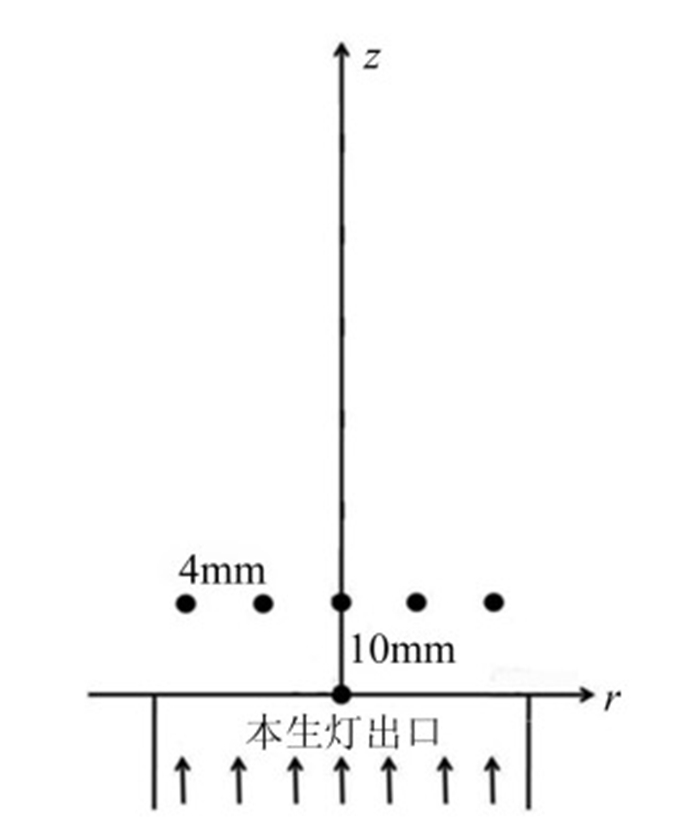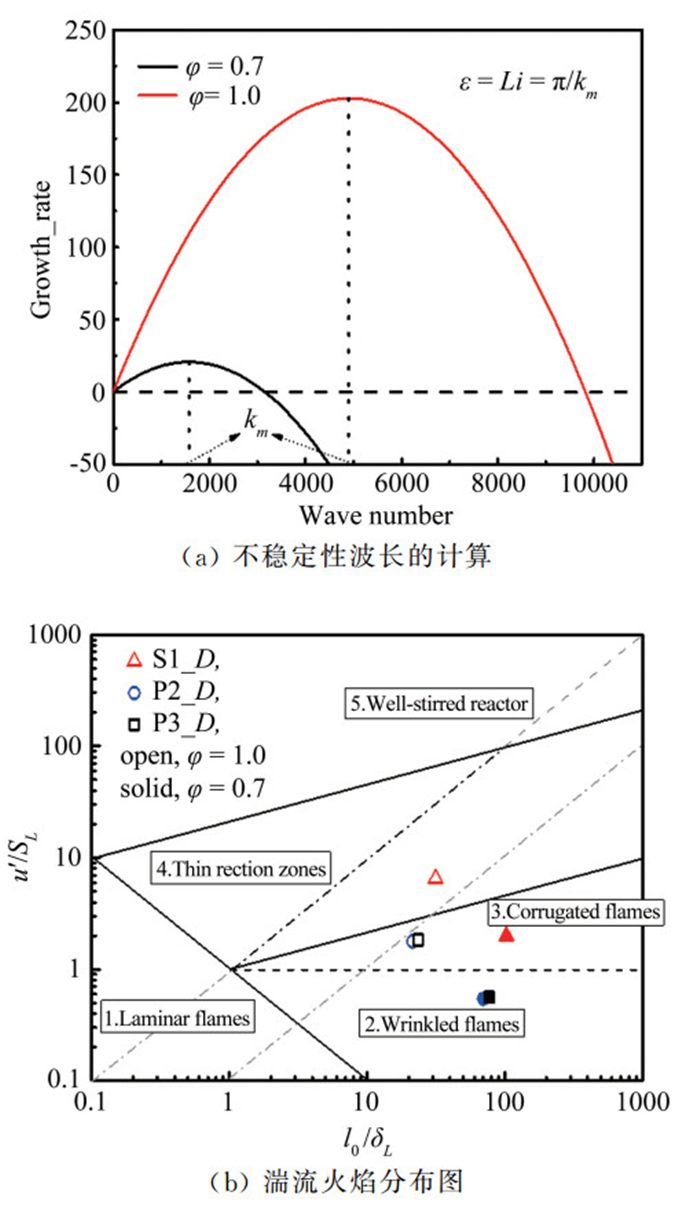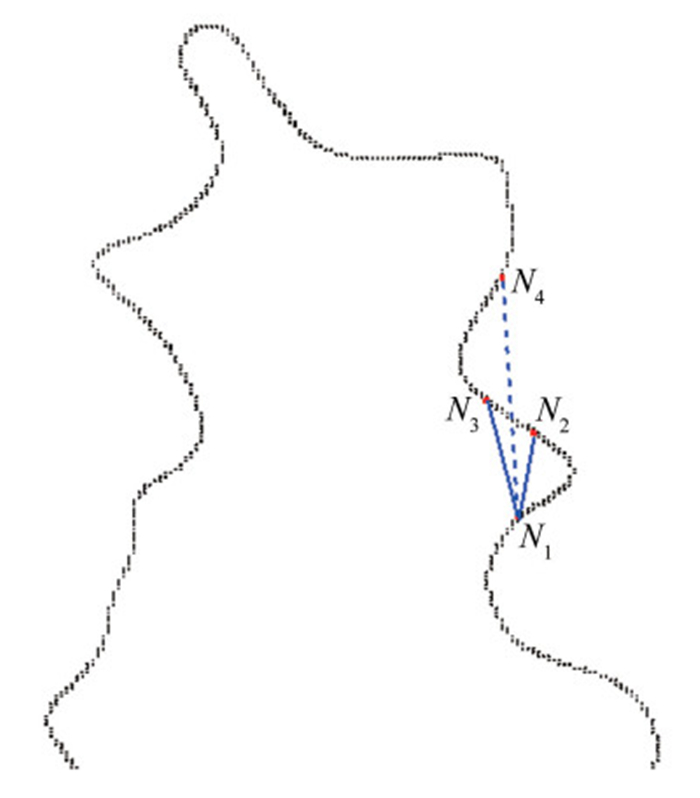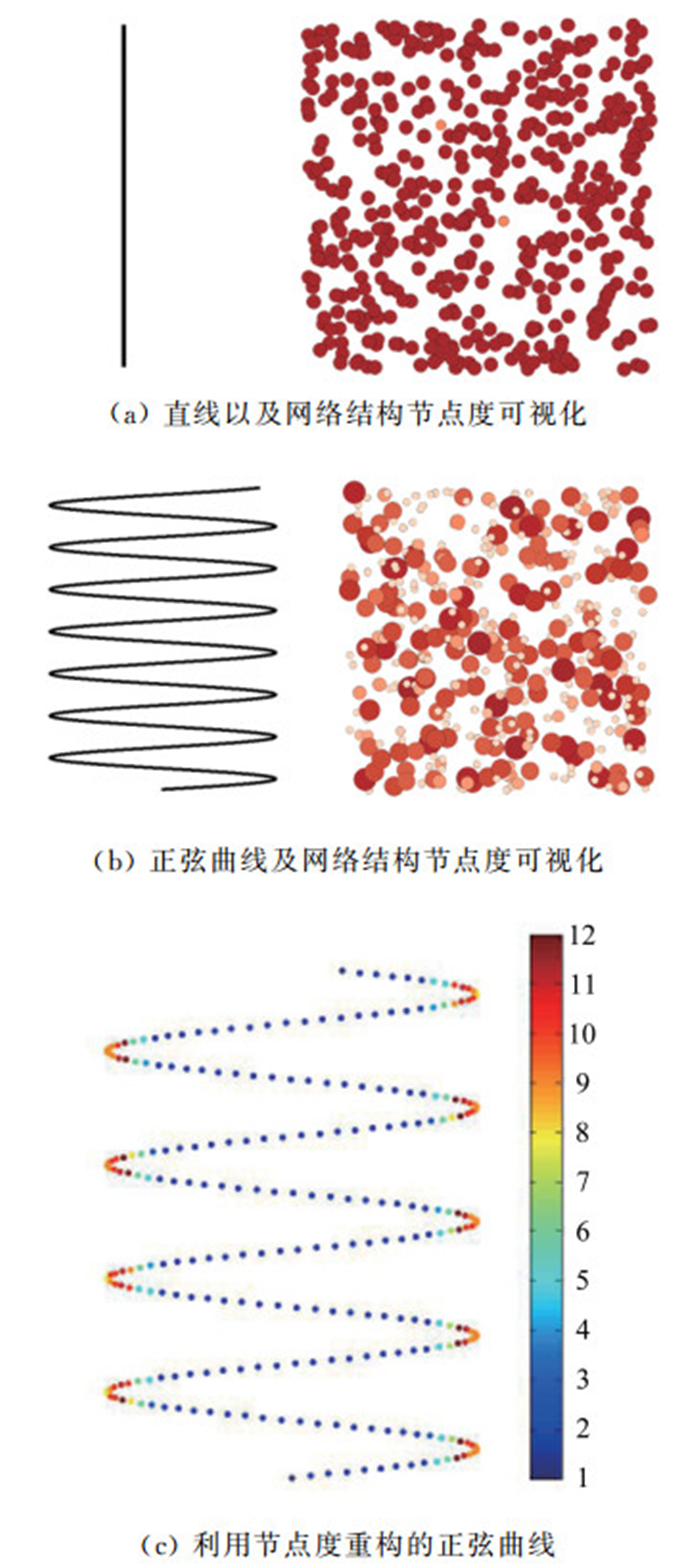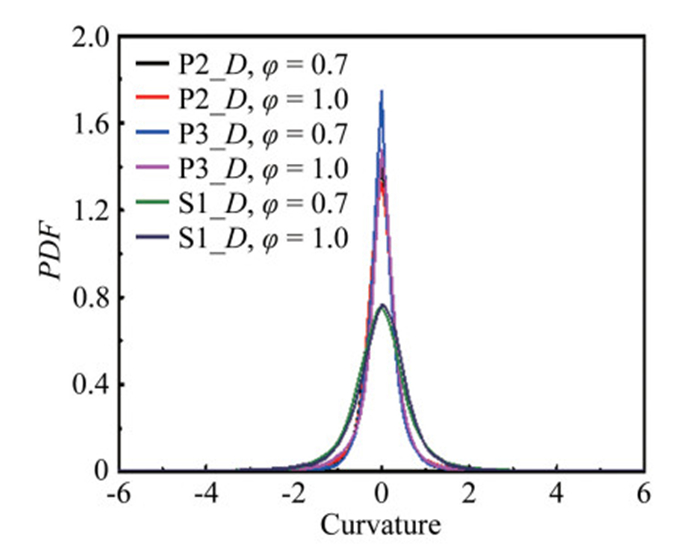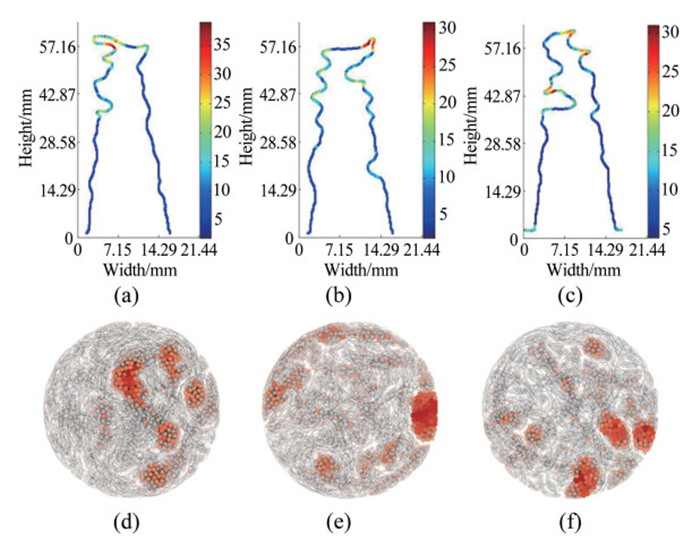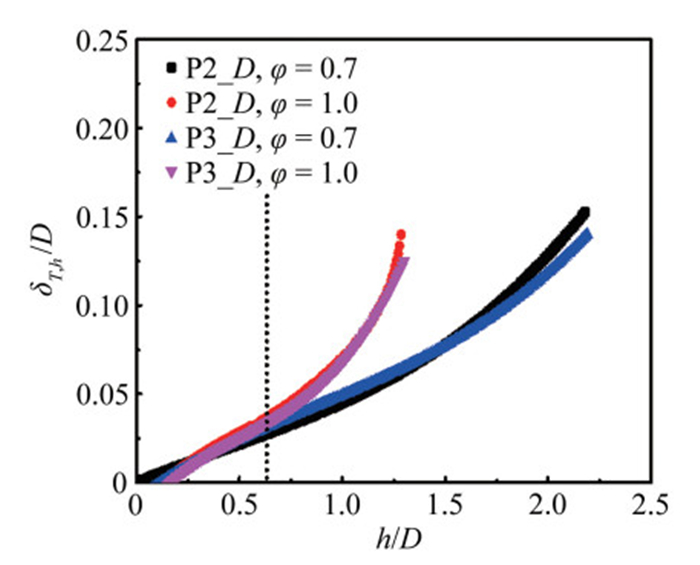Network topology analysis on wrinkled structure of turbulent premixed Bunsen flame
-
摘要: 湍流火焰结构是表征湍流与火焰相互作用的组分、速度、温度等标量场信息,理解湍流与火焰相互作用规律,验证和发展湍流燃烧模型的实验基础。针对传统曲率PDF分布反映湍流火焰面褶皱结构失准问题,利用网络拓扑结构方法可以标记系统关键节点和特征结构,构建湍流火焰面的拓扑结构。本文标记了湍流火焰面上的关键褶皱结构,分析了湍流与火焰的作用规律,结果表明:低湍流强度下,湍流火焰面的关键褶皱结构由火焰自身不稳定性引起;当湍流强度增大,湍流火焰面的关键褶皱结构由湍流尺度决定。在本生灯湍流火焰中,火焰自身不稳定性引起的火焰褶皱与火焰发展距离有关。在本生灯火焰底部,火焰自身不稳定性不引起火焰面褶皱,随着火焰向下游发展,其对火焰面影响逐渐增大,火焰褶皱程度增加。Abstract: Turbulent flame structure represents the species, velocity and temperature field in the turbulent combustion, which reflects the interaction between the turbulence and the combustion. It is also important for combustion model validation. The conventional PDF of curvature method can not accurately reflect the folded regions in the turbulent flame, while the network topology analysis can demonstrate these regions as it can mark the key nodes or structure in a system. In this paper, the network structure of the turbulent premixed Bunsen flame is constructed to trace the folded regions in turbulent flames. Results show that the folded regions can be traced by network structure. These regions are mainly caused by DL instability in weak turbulence, while they are mainly affected by turbulence vortex wrinkling as turbulence intensity increases. The influence of DL instability on turbulent premixed Bunsen flames is constrained by flame development. At the bottom of Bunsen flame, the DL instability does not wrinkle the flame. As the flame propagates to the downstream, the flame becomes more wrinkled due to DL instability.
-
0 引 言
下击暴流是一种在雷暴天气中由强下沉气流猛烈冲击地面而形成并沿地表传播的近地面短时破坏性强风[1]。在雷暴天气中,发生微下击暴流的概率可达60%~70%,产生的近地面强风最大风速可超过60 m/s。在世界范围内,下击暴流造成了大量工程结构物的破坏[2]。
下击暴流具有较强的突发性,较难记录实际的下击暴流事件,因此,风洞试验是研究下击暴流的主要手段。实验室研究下击暴流普遍采用冲击射流装置。早期,冲击射流装置主要用于模拟平稳风场特性,由于水平放置,一定程度上会受到地面的影响。之后,通过将喷嘴悬挂于足够高处,尽量排除了地面的影响[3]。此类试验在后续研究中得到了进一步改进,形成了移动式壁面射流装置[4-5]。同时,可以通过控制冲击射流阀门的开启速度来实现非稳态的下击暴流模拟[6]。国内对下击暴流的物理模拟相对较晚。浙江大学[7]与中国空气动力研究与发展中心[8]建成了类似的动量冲击射流装置。
从物理模型角度而言,冲击射流是模拟下击暴流的逻辑相似模型。然而,由于实验室条件的限制,很难采用冲击射流对下击暴流开展大尺度、较快平移速度的试验研究。即便能够快速移动,试验缩尺比也较小,需要较大的试验空间。目前,国内外文献中最大的喷嘴直径为4.5 m[9],对于如此大的设备,模拟下击暴流的平动(速度可达水平风速的1/3)是非常困难的。
由于下击暴流出流段的平均风速剖面符合典型的平面壁面射流特征,Lin等[10]提出了一种新的物理模型,采用壁面射流装置研究了二维平面内的下击暴流出流段的流场特征,并在常规边界层风洞中对下击暴流出流段进行了模拟[11],实现了传统风洞试验中的几何缩尺(1∶100~1∶250)。但前期的研究尚未考虑下击暴流中雷暴云的平动作用。段旻等[12]通过一个缩聚装置在边界层风洞中得到了壁面射流,模拟了下击暴流平均风速剖面;辛亚兵等[13]采用类似装置研究了稳态下击暴流作用下的大跨连续刚构桥风振响应。
现有下击暴流风场模拟试验装置大部分仅模拟下击暴流稳态风场,而对下击暴流的非稳态风场模拟较少。实际上,空间层面的下击暴流是三维的,产生的涡系是环状扩散的,而采用带协同流的壁面射流模型仅能模拟二维平面流动情况。为了评估采用二维壁面射流模拟三维下击暴流出流段风场的准确性,Lin等[10]对理想下击暴流出流段的二维性假设进行了验证,研究表明平面壁面射流与径向冲击射流在横风向的误差完全可以忽略;即使存在较大的分流角度,阵风前端产生的正面曲率效应对下击暴流中心线(移动路径)流场的影响也非常微弱。总体来看,壁面射流模型与下击暴流的流动机制并不完全相同,但在造成结构物破环的主要区域—出流段—采用壁面射流模型完全能够模拟下击暴流出流段风场的主要特征。
根据Joint Airport Weather Studies(JAWS)的实测总结[14],下击暴流破坏的大概率区域主要位于出流段,占整个下击暴流风场的90%以上,如图1所示(图中um表示局部最大风速)。因此,在常规边界层风洞中采用壁面射流方法进行风洞试验,可以实现更大的几何缩尺比。本文在参考已有研究的基础上,设计制作了基于大气边界层风洞的非稳态风场模拟装置。在常规边界层风洞的基础上,通过增加壁面射流喷口及风机,在喷口处布置气动阀门,实现对边界层风洞中下击暴流出流段非稳态风场的模拟。
1 试验概况
1.1 非稳态风场模拟装置
试验在重庆大学直流式教学风洞中进行。通过改进文献[10]提出的壁面射流方法并对风洞进行改装,使直流式边界层风洞具备了壁面射流模拟功能,如图2所示。风洞试验段尺寸为2.4 m×1.8 m×15.0 m(宽×高×长)。壁面射流装置加装于试验段入口位置,通过4个千斤顶与支架连接,可实现壁面射流装置的上升与下降:当进行壁面射流试验时,以千斤顶将壁面射流装置上升至与试验段底面平齐;试验完成后,降下壁面射流装置,可以常规使用边界层风洞。壁面射流装置分为动力段、过渡段、稳流段、回转段和射流喷口。动力段采用3台风机并联安装;回转段采用对数螺旋线设计,尽量减小由于风场转向导致的风速损耗;壁面射流喷口的高度b=60 mm,宽度与边界层风洞基本一致,最大出流速度为45 m/s。
大多数下击暴流同时伴随雷暴云层的平动,这种平动会导致雷暴云层前端下击暴流风场速度增大,增大至峰值后迅速衰减。下击暴流的这种时变特征与常规边界层稳态风场有着极大的不同,因此,对于平动型下击暴流,需要考虑其非稳态风场特性。通过在壁面射流喷口段安装快开阀门,可以形成具有下击暴流风速剖面的突变风场,实现时变下击暴流风场的试验模拟;通过阀门控制壁面射流的流量大小,实现喷口风速的非线性脉动冲击模拟。阀门快开由伸缩气缸完成,并增加手动节流阀以调节气缸运动速度,实现阀门开/闭时间可调(1~10 s范围内),如图3所示。试验风场采用眼镜蛇三维脉动风速采集系统(Series 100 Cobra Probe)进行采集,采样频率为512 Hz。
2 风场模拟结果
2.1 稳态风场结果
当阀门保持全开、喷口出流速度为28.30 m/s时,壁面射流不同顺流向位置的平均风速剖面如图4所示,湍流度剖面如图5所示。图中,x为顺流向位置,y为竖直高度方向位置(坐标系如图2所示)。可以看出,在测量高度范围内,基本没有回流的出现,随着顺流向距离的增大,风速剖面下部的速度逐渐减小,而上部速度逐渐增大,转折区域约在200~300 mm范围内。壁面射流湍流度剖面则呈现出明显的双峰特征(即内层近壁面峰值与外层峰值),且随着顺流向距离的增大,外层峰值出现的竖向高度位置不断上移。
为得到壁面射流的自相似剖面,通常采用特征长度与特征速度对其进行无量纲处理[15]。壁面射流的无量纲速度剖面如图6所示。可以看出,壁面射流风洞试验结果表现出较好的自相似性,仅在x=20 b处有一定偏差,这是由于此位置壁面射流转捩没有完成,尚未进入完全发展阶段。风洞试验与Eriksson等[16]的试验结果、三种典型下击暴流风速剖面经验模型[17-19]非常吻合。
2.2 非稳态风场结果
实际上,下击暴流风场中各位置的风速与距离下击暴流冲击地面点的相对位置、下击暴流雷暴云的平动速度、下沉气流的出流速度和高度以及下击暴流的出流强度有关,这些因素同样具有较强的随机性。因此,本文仅通过控制快开阀门的转动速度和转动角度,重点模拟下击暴流随时间的变化及其竖向风速剖面,未考虑同一下击暴流事件中不同位置的风速分布特征。
通过手动节流阀控制伸缩气缸气压大小,调整阀门开关时间。如图7所示,瞬态风场采用2个眼镜蛇探头同时进行测量,测量的竖向位置分别为30、50、80、120、200、300和500 mm,一个探头固定于30 mm处,另一个探头则上下移动。在测量不同高度的风速时,数据采集时间并不同步,因此,通过统一最大风速对应的时间点,采用固定探头对不同高度的风速进行时间同步,从而更加合理地分析竖向风场特征[20]。下击暴流的实测记录较少,本文选择文献中可用的安德鲁斯空军基地(Andrews AFB)下击暴流实测记录作为目标事件[1],从而得到典型的下击暴流风速时程。
任意高度处下击暴流的顺流向风速可以分解为确定的时变平均分量
$ \overline V \left( {{\textit{z}},t} \right) $ 和脉动分量$ v'\left( {{\textit{z}},t} \right) $ [21]:$$ V\left( {{\textit{z}},t} \right) = \overline V \left( {{\textit{z}},t} \right) + v'\left( {{\textit{z}},t} \right) $$ (1) 其中,平均风速随时间连续变化且能够反映原始风速的变化趋势。Su等[22]采用不同的方法研究时变平均风速与脉动风速的分离,建议采用高阶的离散小波变换(DWT)与总体经验模态分解(EEMD)方法提取时变平均风速,就能够较好地反映原始风速的变化趋势。因此,本文采取高阶的DWT方法(采用10阶小波)进行时变平均风速的分离。当阀门开启时间为3 s、壁面射流出流速度为33.06 m/s时,x=100 b处移动探头在不同高度时(50、80和120 mm)固定探头的时变平均风速如图8所示。图例中的2个高度分别表示固定探头和移动探头所在的竖向高度位置。
可以看出,由壁面射流装置及阀门开关产生的出流速度在每次试验中都存在一定差异,这主要是由电机启动扭矩、制动性能以及手动节流阀中气压大小的不确定性所导致。因此,在测量风速时,移动探头在每个高度处进行6次重复试验,挑选较为接近的几组数据中的一组数据作为最终结果。壁面射流出流速度为33.06 m/s、主风洞产出的环境风速为6.60 m/s时,x=100 b处不同高度的风速时程以及时变平均风速和脉动风速的分离如图9所示。
从图9可以看出,不同高度处的风速时程都呈现出2个峰值的特征,且随着高度增大,最大平均风速减小,说明采用本文方法能有效模拟典型下击暴流出流段风速的时变特征。最大时变平均风速竖向剖面如图10所示(图中阴影区域为Hjelmfelt[14]统计的实测数据区间),可以看出:竖向风速剖面表现出下击暴流典型风速剖面的基本特征,与Hjelmfelt的实测数据较为吻合;但由于测点较少,且仅是取时变平均风速的最大值,曲线并不非常平滑。
下击暴流最大风速发生高度约为0.02~0.05 D(D为下击暴流出流直径)[23-24]。从图4和10可以看出,顺流向x=100 b处的最大风速大约发生在竖向高度80 mm处,可以估计出该位置的等效直径约在2.67~1.60 m范围内。Abd-Elaal等通过大量参数分析,估计出Andrews AFB下击暴流的出流直径约为660 m[24]。因此,本文的壁面射流装置在x=100 b处模拟Andrews AFB下击暴流的缩尺比约为1∶247~1∶412。出流速度为33.06 m/s时,最大时变平均风速为15.70 m/s,Andrews AFB下击暴流最大瞬时风速约为66.82 m/s[1],对其移动平均后得到的最大风速为54.21 m/s,如图11所示,可以得到速度缩尺比为1∶3.67,需要模拟的时间缩尺比为1∶67.30~1∶112.26。从图11可以看出,风速从开始增大直至峰值所需时间约为105 s,因此需要阀门打开的时间为0.94~1.56 s。取阀门打开时间为1.50 s进行模拟,模拟结果如图12所示。从图中可以看出:风洞试验结果和实际的下击暴流具有较好的吻合度,特别是在第一个峰值处,而在第二个峰值处较实际风场偏大。
不同顺流向位置的最大风速高度基本不变,因此,通过调节壁面射流的出流速度控制速度缩尺比,根据阀门开启的速度控制时间缩尺比,能够有效得到目标风场的时变风速。
顺流向x=100 b处的湍流度竖向剖面如图13所示。由于缺乏下击暴流的实测湍流度竖向剖面,本文采用中国《建筑结构荷载规范》(GB 50009—2012)[25]中的大气边界层风场与试验结果进行对比。下击暴流风速具有时变特征,因此湍流度的计算并没有固定方法。本文湍流度采用特征时间内脉动风速的均方根值与最大平均风速的比值。其中,定义特征时间为下击暴流冲击地面后、风速从开始急剧增大至衰减为最大风速一半所需的时间[26]。
从图13可以看出,风洞试验结果在近地面与规范值较为一致,当竖向高度超过最大风速所在高度后(0.05 D,30 m),湍流度迅速增大,这是由于壁面射流风场与边界层风场发生混合,涡旋的产生与耗散加速,这与稳态壁面射流试验中得到的湍流度剖面非常类似。
风洞试验x=100 b、竖向高度80 mm处的特征时间内脉动风速功率谱如图14所示,图中同时给出von Karman谱进行对比。根据Kolmogorov湍流能谱假设,在惯性子区内,湍流的能量将由最小尺度的涡耗散,这种涡的尺度称为Kolmogorov长度尺度,而惯性子区内的湍流能谱满足“−5/3定律”。从图中可以看出,特征时间内脉动风速功率谱与30 m处的von Karman谱在5 Hz之后吻合,并且符合“−5/3定律”。
从上述分析可以看出,采用壁面射流装置能够较好地实现下击暴流出流段风场的模拟,主要包括竖向风速剖面以及时变风速时程。对于湍流度,由于下击暴流的湍流度缺乏实测资料,无法进行对比研究,本文仅研究了光滑壁面一种情况,尚未考虑粗糙元的设置。总体而言,采用壁面射流装置模拟下击暴流非稳态风场是较为有效的。
3 结 论
基于平面壁面射流模型,在边界层风洞中模拟了稳态及非稳态下击暴流出流段风场,结果表明:
1)稳态壁面射流湍流度剖面呈现出明显的双峰特征(内层近壁面峰值与外层峰值),且随着顺流向距离的增大,外层峰值出现的竖向高度位置不断上移;而随着射流出流速度的增大,湍流度呈增大趋势,外层峰值出现的竖向高度位置也上移。
2)与中国规范湍流度相比,非稳态壁面射流湍流度剖面在最大风速高度以下较为接近,而在最大风速高度之上,非稳态壁面射流湍流度较规范值偏大。
3)采用壁面射流装置产生的下击暴流非稳态出流段风速功率谱与von Karman谱较为吻合,且符合“–5/3定律”。
4)基于平面壁面射流方法的下击暴流模拟试验装置在边界层风洞中可实现非稳态风场模拟,为下击暴流水平风场作用下的结构响应研究打下基础。
-
表 1 甲烷实验工况
Table 1 Experiment condition of methan flames
孔板 φ Uave u′ SL0 l0 l h Li S1_D 0.7 3 0.74 19.0 5.57 0.34 0.08 2 S1_D 1.0 3 0.74 37.1 5.57 0.34 0.08 0.64 P3_D 0.7 3 0.21 19.0 4.18 0.55 0.19 2 P3_D 1.0 3 0.21 37.1 4.18 0.55 0.19 0.64 P2_D 0.7 3 0.17 19.0 4.59 0.66 0.24 2 P2_D 1.0 3 0.17 37.1 4.59 0.66 0.24 0.64 -
[1] Peters N. Turbulent combustion[M]. Cambridge University Press, 2000.
[2] Tamadonfar Parsa, Gülder ömer L. Flame brush characteristics and burning velocities of premixed turbulent methane/air Bunsen flames[J]. Combustion and Flame, 2014, 161(12):3154-3165. DOI: 10.1016/j.combustflame.2014.06.014
[3] Fragner R, Halter F, Mazellier N, et al. Investigation of pressure effects on the small scale wrinkling of turbulent premixed Bunsen flames[J]. Proceedings of the Combustion Institute, 2015, 35(2):1527-1535. DOI: 10.1016/j.proci.2014.06.036
[4] Poludnenko A Y, Oran E S. The interaction of high-speed turbulence with flames:Global properties and internal flame structure[J]. Combustion and Flame, 2010, 157(5):995-1011. DOI: 10.1016/j.combustflame.2009.11.018
[5] Lipatnikov A N, Chomiak J. Effects of premixed flames on turbulence and turbulent scalar transport[J]. Progress in Energy and Combustion Science, 2010, 36(1):1-102. DOI: 10.1016/j.pecs.2009.07.001
[6] Nishiki S. Modeling of flame-generated turbulence based on direct numerical simulation databases[J]. Proceedings of the Combustion Institute, 2002, 29:2017-2022. DOI: 10.1016/S1540-7489(02)80246-2
[7] Lipatnikov A N, Chomiak J. Turbulent flame speed and thickness:phennomenology, evaluation, and application in multi-dimensional simulations[J]. Progress in Energy & Combustion Science, 2002, 28:1-74. https://www.sciencedirect.com/science/article/pii/S0360128501000077
[8] Fureby C. A fractal flame-wrinkling large eddy simulation model for premixed turbulent combustion[J]. Proceedings of the Combustion Institute, 2005, 30(1):593-601. DOI: 10.1016/j.proci.2004.08.068
[9] Cintosun Esen, Smallwood Gregory J, Gülder ömer L. Flame surface fractal characteristics in premixed turbulent combustion at high turbulence intensities[J]. AIAA Journal, 2007, 45(11):2785-2789. DOI: 10.2514/1.29533
[10] Bradley D. Application of a reynolds stress, stretched flamelet, mathematical model to computations of turbulent burning velocities andcomparison with experiments[J]. Combustion & Flame, 1994, 96:221-248. https://www.sciencedirect.com/science/article/pii/0010218094900116
[11] Yeung P K. Lagrangian statistics from direct numerical simulations of isotropic turbulence[J]. Journal of Fluid Mechanics, 1989, 207:531-586. DOI: 10.1017/S0022112089002697
[12] Pope S. Lagrangian PDF methods for turbulent flows[J]. Annu Rev Fluid Mech, 1994, 26:23-63. DOI: 10.1146/annurev.fl.26.010194.000323
[13] Chaudhuri S. Life of flame particles embedded in premixed flames interacting with near isotropic turbulence[J]. Proceedings of the Combustion Institute, 2015, 35(2):1305-1312. DOI: 10.1016/j.proci.2014.08.007
[14] Chen H J. The mechanism of two-dimensional pocket formation in lean premixed methane-air flames with implications to turbulent combustion[J]. Combustion & Flame, 1999:15-48. http://cn.bing.com/academic/profile?id=91691432f860044c4cc75574cbba6e55&encoded=0&v=paper_preview&mkt=zh-cn
[15] Liu C, Zhou W X, Yuan W K. Statistical properties of visibility graph of energy dissipation rates in three-dimensional fully developed turbulence[J]. Physica A:Statistical Mechanics and its Applications, 2010, 389(13):2675-2681. DOI: 10.1016/j.physa.2010.02.043
[16] Murugesan Meenatchidevi, Sujith R I. Combustion noise is scale-free:transition from scale-free to order at the onset of thermoacoustic instability[J]. Journal of Fluid Mechanics, 2015, 772:225-245. DOI: 10.1017/jfm.2015.215
[17] 张猛, 王金华, 谢永亮, 等.利用OH_PLIF测量CH4/H2/空气混合气湍流燃烧速率[J].燃烧科学与技术, 2013, 19(6):512-516. http://gxhx.cbpt.cnki.net/WKB2/WebPublication/wkTextContent.aspx?contentID=&colType=4&yt=2017&st=05 Zhang M, Wang J H, Xie Y L, et al. Measurement of turbulent burning velocity of CH4/H2/Air mixtures using OH-PLIF[J]. Journal of Combustion Science and Technology, 2013, 19(6):512-516. http://gxhx.cbpt.cnki.net/WKB2/WebPublication/wkTextContent.aspx?contentID=&colType=4&yt=2017&st=05
[18] Zhang M, Wang J H, Wu J, et al. Flame front structure of turbulent premixed flames of syngas oxyfuel mixtures[J]. International Journal of Hydrogen Energy, 2014, 39(10):5176-5185. DOI: 10.1016/j.ijhydene.2014.01.038
[19] Kobayashi H, Tamura T, Maruto K, et al. Burning velocity of turbulent premixed flames in a high pressure environment[J]. Proceedings of the Combustion Institute, 1996, 26(1):389-396. DOI: 10.1016/S0082-0784(96)80240-2
[20] 张猛, 王金华, 俞森彬, 等.自适应阈值二值法提取湍流火焰前锋面结构[J].燃烧科学与技术, 2016, 22(3):212-217. http://journals.tju.edu.cn/rs/oa/scriptlsit.aspx?kind=Field&colid=1 Zhang M, Wang J H, Yu S B, et al. Flame front tracking of turbulent premixed flames using adaptive threshold binarization[J]. Journal of Combustion Science and Technology, 2016, 22(3):212-217. http://journals.tju.edu.cn/rs/oa/scriptlsit.aspx?kind=Field&colid=1
[21] Luque B, Lacasa L, Ballesteros F, et al. Horizontal visibility graphs:Exact results for random time series[J]. Physical Review E Statistical Nonlinear & Soft Matter Physics, 2009, 80(2):046103. http://cn.bing.com/academic/profile?id=71d2259316f2903d95668ed2a6c721a5&encoded=0&v=paper_preview&mkt=zh-cn
[22] Bresenham J E. Algorithm for computer control of a digital plotter[J]. IBM Systems Journal, 1965, 4(1):25-30. DOI: 10.1147/sj.41.0025
[23] Barabasi A L, Albert R. Emergence of scaling in random networks[J]. Science, 1999, 286(5439):509. DOI: 10.1126/science.286.5439.509
[24] Hamlington P E, Poludnenko A Y, Oran E S. Interactions between turbulence and flames in premixed reacting flows[J]. Physics of Fluids, 2011, 23(12):125111. DOI: 10.1063/1.3671736
[25] Chakraborty N, Klein M, Swaminathan N. Effects of lewis number on the reactive scalar gradient alignment with local strain rate in turbulent premixed flames[J]. Proceedings of the Combustion Institute, 2009, 32(1):1409-1417. DOI: 10.1016/j.proci.2008.06.021
[26] Fruchterman T M J, Reingold E M. Graph drawing by force-directed placement[J]. Software Practice & Experience, 2010, 21(11):1129-1164. http://cn.bing.com/academic/profile?id=47fec71599586b4db1914c25cba86c0e&encoded=0&v=paper_preview&mkt=zh-cn
[27] Scholz M. Node similarity as a basic principle behind connectivity in complex networks[J]. Computer Science, 2015:1-7. http://cn.bing.com/academic/profile?id=ddb6e0727cf2e5cf67a5ef7efd3ee4ec&encoded=0&v=paper_preview&mkt=zh-cn
[28] Boyer L, Quinard J. On the dynamics of anchored flames[J]. Combustion & Flame, 1990, 82(1):51-65. http://cn.bing.com/academic/profile?id=a9bbda85daa4eb50d8e2717d186a4bfc&encoded=0&v=paper_preview&mkt=zh-cn
[29] Lieuwen T. Local consumption speed of turbulent premixed flames-An analysis of "memory effect"[J]. Combustion & Flame, 2010, 157:955-965. http://www.sciencedirect.com/science/article/pii/S0010218009002855
[30] Clavin P, Williams F A. Theory of premixed-flame propagation in large-scale turbulence[J]. Journal of Fluid Mechanics, 2006, 90(3):589-604. http://cn.bing.com/academic/profile?id=72b3b47bc5a56ca0ac6ef4860f677a1b&encoded=0&v=paper_preview&mkt=zh-cn
[31] Aldredge R C, Williams F A. Influence of wrinkled premixed-flame dynamics on large-scale, low-intensity turbulent flow[J]. Journal of Fluid Mechanics, 2006, 228(228):487-511. http://cn.bing.com/academic/profile?id=7af3354618aef0574a574540cba8b3c8&encoded=0&v=paper_preview&mkt=zh-cn
[32] Tamadonfar Parsa, Gülder ömer L. Effects of mixture composition and turbulence intensity on flame front structure and burning velocities of premixed turbulent hydrocarbon/air Bunsen flames[J]. Combustion and Flame, 2015, 162(12):4417-4441. DOI: 10.1016/j.combustflame.2015.08.009
-
期刊类型引用(4)
1. 汪之松,王宇杰,余波,徐晴,何勇,李正良. 不同风场中特高压换流站阀厅屋盖风压特性试验研究. 振动与冲击. 2024(02): 146-155 .  百度学术
百度学术
2. 《中国公路学报》编辑部. 中国桥梁工程学术研究综述·2024. 中国公路学报. 2024(12): 1-160 .  百度学术
百度学术
3. 辛亚兵,刘志文,陈浩. CAARC高层建筑标准模型下击暴流风洞试验. 湖南大学学报(自然科学版). 2023(07): 151-159 .  百度学术
百度学术
4. 张传雄,叶思成,郑华,黄张琦,郑峰,王艳茹,李正农. 温州地区台风和下击暴流风场特征观测研究. 自然灾害学报. 2023(06): 113-122 .  百度学术
百度学术
其他类型引用(2)







 下载:
下载:

















